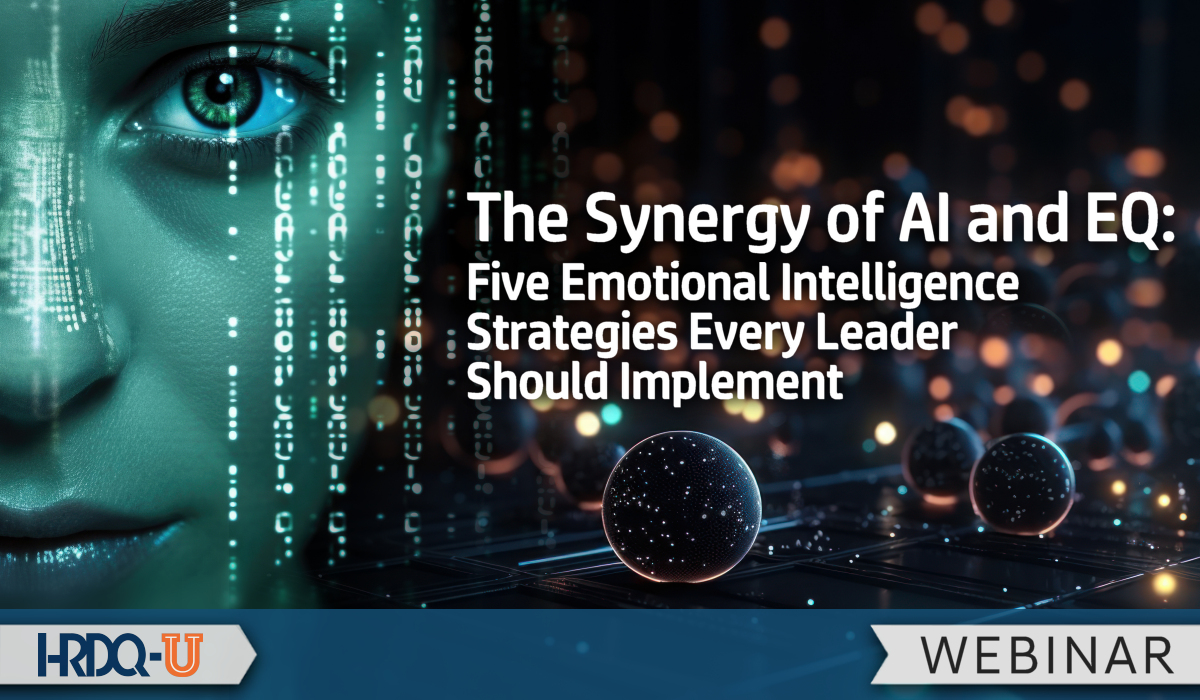- 827 Lincoln Ave. #B-10 West Chester, PA 19380
- support@hrdq.com
- +1-610-279-2002
Quick Links
Menu
Featured Topics
Menu
Total Results
We could not find what you're looking for. Please try again.No Record Found

In the wake of the Fourth Industrial Revolution, Artificial Intelligence (AI) is no longer a distant future concept but a vital component of our daily lives. Yet, while AI is changing the business landscape, Emotional Intelligence (EQ) remains the cornerstone of effective leadership.
Welcome to an innovative and exciting journey where we’ll reveal the power of AI and EQ! Over the course of an hour, our webinar will illuminate how the harmonious merger of AI and EQ is crucial to successful leadership.
You’ll join our lively panel of thought leaders, AI experts, and executive coaches as they delve into an engaging exploration of these two seemingly disparate areas. We’ll look at case studies, discuss real-world applications, and reveal the five pivotal strategies every leader needs in this AI-driven era.
You’re in for a fun and informative ride that promises to be as engaging as it is enlightening. We will have quizzes, interactive Q&A sessions, and some surprise elements to ensure that your learning journey is never dull.
This webinar is more than a presentation – it’s a clarion call for innovators, leaders, and trailblazers like you. It’s time to redefine your leadership blueprint, harness the power of AI while leveraging EQ, and lead the charge in this brave new world.
As leaders, we cannot afford to be complacent. Now is the time to enhance our skills and capabilities. To succeed in this new world order, we need to create a balanced amalgamation of AI and EQ. Join us to take the first step in revolutionizing your leadership strategy.


How to Manage Your Emotions Customizable Courseware
Develop the tools necessary to identify emotional triggers, manage physical and emotional responses, and navigate the emotions of others. This course will help improve your communication with colleagues and supervisors, redirect negative energy into more positive endeavors, and enhance overall emotional intelligence.
Take 15% OFF this course with code MANAGEYOUREI
Judith Cardenas is the President and CEO of Strategies By Design, a boutique consulting firm helping organizations across the globe to innovate and design successful solutions and experiences for their clients. She has spent the last 12+ years empowering leaders and organizations to execute their vision and reach their goals through processes focused on innovation, change, and co-creation.
Her academic background includes a doctorate in education administration, as well as a doctorate in training and performance improvement. She has completed a variety of postdoctoral training, including leadership development at Harvard University’s John F. Kennedy School of Government and professional for return on investment from Villanova University, plus she holds a number of certifications in innovation and AI strategy.
Judith has created and delivered training to organizations and agencies such as the World Bank, United Nations, QVC, Inc., Phillips Semiconductor, U.S. Navy, U.S. Nuclear Regulatory Agency and U.S. Army, the National Institute for Staff and Organizational Development/UT Austin.
Strategies By Design specializes in supporting Leaders and Organizations that are ready to innovate faster and more successfully – and want to design better solutions or experiences for their customers and employees. We help foster the culture of innovation needed to stay competitive in today’s modern, ever-changing market, apply innovative techniques and approaches to achieve immediate engagement and growth, and enhance the connection between behavior design and human-centric design.
Visit Strategies By Design
Training Tools for Developing Great People Skills
This event is sponsored by HRDQ. For 45 years HRDQ has provided research-based, off-the-shelf soft-skills training resources for classroom, virtual, and online training. From assessments and workshops to experiential hands-on games, HRDQ helps organizations improve performance, increase job satisfaction, and more.
Learn more at HRDQstore.com

“This webinar helped me generate some ideas for integrating AI within our workplace culture.”
Mike G.
Consultant

“AI is a hot topic recently and this webinar covered enough information to update me as well as teach me how to utilize it.”
Ching S.
Manager

“Great content and presentation, and I would definitely want to hear more on this topic.”
Jackie J.
Manager

Sign up to be notified of upcoming live webinars, in-depth workshops, podcasts, blog posts, promotions and much more. Stay ahead of the curve and subscribe for FREE today!